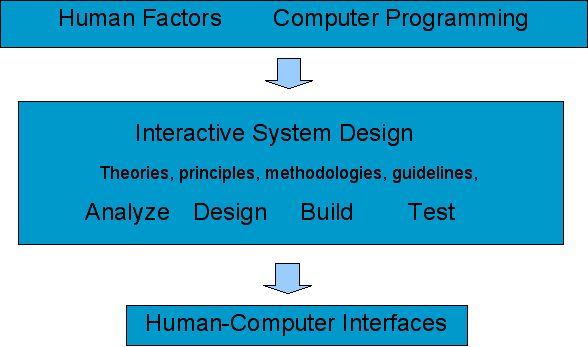

 |
 |
[ Formal Data | Course Tools | Syllabus | Course Books | Course Plan | CourseWeb | Knowledge Tree | Links ]
The goal of this course is to acquaint you with principles and techniques of interactive system design and to help you develop a number of critical scills that will enable you to be employed in the area of user interface design and evaluaton. In particular, we expect every student
Upon satisfactory completion of this course, students will:
Interactive System Design (ISD) is an integral part of Human Computer Interaction (HCI) curriculum. Human Computer Interaction is an important part of Informatics (this is the world often used to cover all science fields related with computers and information processing). HCI is taught at many Computer Science, Information Science and similar schools and departments.
ISD is one of the few core HCI courses that stand on the crossroads of cognitive science courses, computer-programming courses, and advanced system courses. Cognitive science courses such as human information processing or human factors teach you about humans and human side of information systems. System courses teach you about advanced information systems and their technical side. Programming courses give you skills to develop programming artifacts. Core HCI courses bring all that together by teaching you about human-computer interfaces - interactive side of information systems, the side that connects humans with technology.
A course on interactive system design is probably the most important of all core HCI courses. It is supposed to teach how to professionally design and evaluate usable interactive systems. This course has its roots in cognitive science courses and connects to other core HCI courses such as Introduction to HCI or interface development tools.
A graduate degree on human-computer interaction may feature two to four core HCI courses. In this context an ISD course usually concentrates solely on theories, principles, and methodologies of interface design and evaluation. In the context of a broader Information Science degree, ISD is the only core HCI course. In this context, your instructor feels it necessary to extend the traditional content of an ISD course with knowledge that are typically presented in an introductory HCI course (a review of major kinds of interfaces, an introduction to the future generation of HCI). In addition, the instructor will allocate some lecture time to build a bridge between this course, your knowledge of human information processing, and you programming skills.
As you can see from the picture below, the core part of IS2470 course is devoted to the process of design and evaluation of interactive systems, This part will combine teaching fundamental knowledge with teaching some applied skills that will help you in a variety of different careers - from software developer to usability engineer. A smaller part of the course will present a concise overview of human-computer interfaces. The goal of this part is to make you aware about a range of interfaces that can be a target of your design efforts right now and to prepare you to face the new generation of interfaces. The course also provides a brief overview of human information processing issues in the context of interactive system design and a small practical section on developing several kinds of interfaces with Java programming language.

All students taking this course should have working knowledge of any structured programming language (C, C++, C#, Java). The homeworks and the final project will require Java knowledge, however the aspects of Java related to GUI programming will be introduced in class. Students in MSIS program should have IS2300 taken either before or in parallel with IS2470. This rule is not enforced for students outside of MSIS. Neither a Database course nor a working knowledge of SQL is required for taking this version of IS2470.
Course assessment includes attendance, assignments and projects. Each lecture bears 1 attendance point. Each assignment and project bears certain number of points. The instructor also reserves the right to administer unannounced quizzes for up to 5 points each if he feels that the students are not pursuing a resonable amount of assigned reading. Your final grade depends on the percentage of points you have earned. Score < 50% corresponds to F, 50-62.5 is D range, 65.5-75 is C range, 75-87.5 is B range, and 87.5-100 is A range.
This is the list of assignments and projecrs you are expected to perform. Pair activitues 3-4 are performed in pairs. Group projects 5, 7, 8 are performed in groups of of 3-5 students. Every group will have an assigned leader. At the end of the project the leader is expected to evaluate the contribution of each group members. Project grade will be scaled according to individual contributions.
You can earn extra credit points for several things such as asking a good question in class or in a discussion forum, providing a helpful answer in a discussion forum, helping during the lecture, finding errors in slides and examples.
All assignments and projects has to be submitted in paper form on the due date before or after the lecture. In addition, the electronic version of the assigment has to be submitted electronically using Blackboard system at any time by or on the due date (your submissions are time stamped). Naming conditions for electronic submissions are strict. The link should be named exactly as the assigment itself (see the list above). You will lose 1/2 point for every misnamed link. Group works should be submitted by the group leader. All submitted work should bear the number of the assignment/quiz and the authors' name in printed form. By submitting work under your name, you are indicating that you have completed the assignment.
You are expected to be fully aware of your responsibility to maintain a high quality of integrity in all of your work. All work must be your own, unless collaboration is specifically and explicitly permitted as in the course group project. Any unauthorized collaboration or copying will at minimum result in no credit for the affected assignment and may be subject to further action under the University Guidelines for Academic Integrity. You are expected to have read and understood these Guidelines. A document discussing these guidelines was included in your orientation materials.
This course accepts distance students. All course lectures are recorded. All course materials, homeworks, discussions, etc are provided over the Web. Discussion forums and other group communitcation facilities of the CourseWeb system support group communication and project work. You have to be a registered graduate student at SIS and get instructor's permission to take this course over the Web. This option is recommended for students who are temporaty unable to attend weekly lectures due to work assignment or other personal reasons. Course requirements (including group project work) are the same for on-campus and distance students. Attendance policy is adjusted to the presence of distance students.
Class attendance, while not mandatory, is required if you want to succeed in this course. While about 3/4 of the material covered by the lectures could be found in the Course Books, some material is not sufficiently covered by the books. Finally, many lectures include demonstrations and videos. If you have missed the lecture, make sure that you have a copy of the slides and watch the video of the lecture. The links to the lecture recordings are provided on the course portal. Spare copies of lecture slides can be picked up from a folder near the instructor's office or printed from the Web. The attendance credit is engineered to encourage your attendance. Each lecture bears 1 attendance point. The maximum number of attendance poits is 12. If you have not attended a lecture or if you are taking the course over the distance, you can still get up to 1 point for the missed lecture by sending a 1-page lecture summary to the intructor within 5 working days after the lecture.
Homework or projects submitted after due date will be accepted, but your objective grade will be scaled so that you lose 10% of the grade for every late working day. I.e., if you will submit your work one week late, you will lose 50% of the grade. Note that most homework and projects require submission in both electronic and printed form. The submission date (used in calculating late days) is the date when the last of these forms is submitted. In addition, projects have a portion of the grade for presentation of the project. If you will fail to present your project on due date, you will lose these points.
If you have a disability that requires special testing accommodations or other classroom modifications, please, notify both the instructor and Disability Resources and Services by the second week of the term. You may be asked to provide documentation of your disability to determine the appropriateness of accommodations. To notify Disability Resources and Services, call 64807890 (voice or TDD) to schedule and appointment. The office is located in the William Pitt Union, Room 216,
Copyright © 2008 Peter Brusilovsky